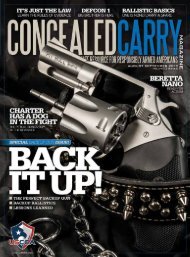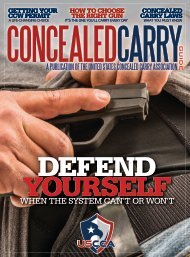Download This Issue - US Concealed Carry
Download This Issue - US Concealed Carry
Download This Issue - US Concealed Carry
You also want an ePaper? Increase the reach of your titles
YUMPU automatically turns print PDFs into web optimized ePapers that Google loves.
SIG SAUER ® ACADEMY<br />
IS “MATCH GRADE” REALLY<br />
NECESSARY FOR A<br />
COMBAT HANDGUN?<br />
[ B Y G E O R G E H A R R I S ]<br />
In reference to firearms,<br />
the term match grade has<br />
a certain mystique as being<br />
better or having an advantage<br />
over the standard model of a<br />
particular product.<br />
For our purposes here we are going<br />
to limit our ideas and comments<br />
to handguns even though long<br />
guns can also be classified as match<br />
grade.<br />
In most cases a match grade handgun<br />
started life as a standard model with<br />
service grade parts and a performance<br />
standard that is generally somewhat<br />
less than that of the match grade product.<br />
Converting a service grade gun to<br />
one of match quality encompasses a<br />
broad spectrum of ideas and processes.<br />
The objective of match quality is most<br />
often thought of as modifying the gun<br />
to make it more accurate intrinsically<br />
and practically. <strong>This</strong> can be done by<br />
tightening the tolerances of the moving<br />
parts, replacing the barrel with one of<br />
higher quality, installing high visibility<br />
sights, applying a custom finish, adding<br />
competition grips, and refining the trigger<br />
pull, among other things.<br />
From a concealed carry perspective,<br />
some of the attributes of a match<br />
grade handgun are valuable and others<br />
are detrimental. At the top of the list of<br />
desirables for a fighting handgun is reliability.<br />
It won’t matter how accurate the<br />
gun is if we can’t get a bullet out of the<br />
barrel when we need to. We have had<br />
students bring guns to our <strong>Concealed</strong><br />
<strong>Carry</strong> classes at the Sig Sauer Academy<br />
that were so tightly fit that they would<br />
only shoot ball ammo, and required a<br />
regular reapplication of lubricant during<br />
the day’s live fire drills just to keep<br />
them running. The intrinsic (mechanical)<br />
accuracy is usually outstanding in<br />
these pistols and is virtually always superior<br />
to the shooter’s ability to use it.<br />
The fact that it is unreliable determines<br />
that it is not a candidate for concealed<br />
carry or self defense.<br />
When it comes to reliability, those<br />
who replace their factory barrels with<br />
custom barrels that have match chambers<br />
are really walking a fine line. A<br />
match chamber is usually toleranced<br />
at a minimum dimension to achieve<br />
the highest possible level of accuracy.<br />
<strong>This</strong> allows no error for the cartridge<br />
that is on the large size of the ammunition<br />
specification to tolerate any firing<br />
residue left by previously fired rounds<br />
or any minor amount of dirt picked up<br />
from the magazine or carry medium.<br />
The mouth of the chamber at the transition<br />
point from the feed ramp, and the<br />
feed ramp itself, are critical areas in getting<br />
a single round from the magazine<br />
into the chamber. From a practical perspective,<br />
in order to insure reliability we<br />
must allow for the mechanical variables<br />
as well as the unknowns that seem to<br />
crop up unannounced.<br />
To be considered acceptable for self<br />
defense purposes, the gun should shoot<br />
any factory ammunition of the correct<br />
caliber with total reliability.<br />
The term match trigger has many<br />
definitions. Usually it alludes to the<br />
properties perceived as necessary for<br />
the shooter to deliver accurate fire on<br />
a specific target. These properties include<br />
trigger weight, smoothness, stroke<br />
length, and reset distance; all of which<br />
have diminishing value as the stress<br />
level increases. In fact, the higher values<br />
of trigger stroke length and weight,<br />
in moderation, serve to decrease unintentional<br />
discharges while having little<br />
effect on hit probability in street con-<br />
About the Author:<br />
George Harris has spent over 30 years<br />
in the field of adult education with<br />
more than 17 years<br />
at the SIG SAUER ®<br />
12<br />
Academy. He has<br />
focused his efforts<br />
in the arenas of<br />
small arms, small<br />
arms training and<br />
combat skill development.<br />
George<br />
has evolved from an infantry soldier,<br />
small arms repair technician, and<br />
drill instructor to become the coach<br />
and firing member of the internationally<br />
recognized United States Army<br />
Reserve Combat Marksmanship Team.<br />
As a competitive shooter, George<br />
has the coveted distinction of being<br />
Distinguished with both the service<br />
pistol and the service rifle. As director<br />
of the SIG SAUER ® Academy, George is<br />
committed to the safe and successful<br />
use of firearms by armed professionals<br />
and responsible citizens alike through<br />
using the SIG Principle of Training:<br />
Simple Is Good!<br />
Sponsored By:<br />
sigsauer.com 603-679-2003<br />
<strong>US</strong>CONCEALEDCARRY.COM n CONCEALED CARRY MAGAZINE n JULY 2008
















